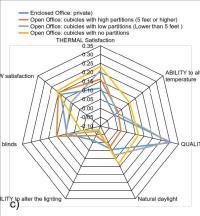Visual Qualities and Perceived Thermal Comfort-results of Survey Studies in a LEED Platinum Office Building

Occupants are exposed to various interlinked environmental factors in office spaces. Office spaces have visual qualities, spatial characteristics, and building features that can have a significant impact on their overall perceived comfort and perceived thermal comfort. The analysis used subjective responses from 500 occupants collected from an energy efficient LEED platinum building in Charlotte, North Carolina. The survey addressed visual qualities of IEQ factors. Based on the occupant survey, empirical analyses have examined the effects and interactions of Indoor Environmental factors on occupant perceptions. This evaluation was executed in different personal attributions, spatial locations, and configurations (classified by different floors, office layouts, distance to windows and cardinal directions) of their workspace.
The results indicated that pleasant visual qualities could positively impact the perception of thermal comfort, even when other measured visual or thermal comfort problems existed. Enhancing visual comfort (lighting and view) can improve occupants’ perception of thermal satisfaction indirectly and may provide better indoor conditions in office buildings. The study implies that occupant surveys can offer a systematic measure for evaluating office spaces to enhance the perceived comfort.
keywords: Thermal comfort, Thermal perception, Visual qualities, View, Quality of lighting
More Like This
- Investigation of the Relationship of the Thermal Comfort Perception Between the Local and Whole Body Segments in a Workplace Environment
- A Design Decision Support Tool for Visual Comfort Evaluation under Daylighting Conditions
- Environmental Measurements of Classrooms at the Florida A and M University


Add comment
Log in to post comments